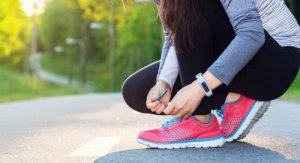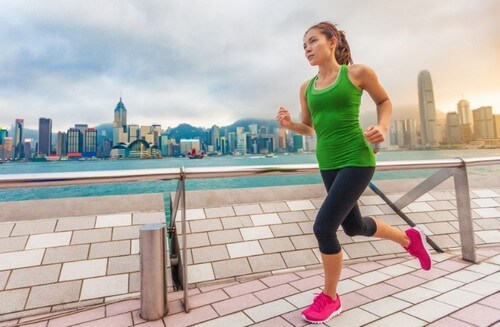Choosing the Right Running Shoes

Choosing the right running shoes is, without a doubt, one of the most important aspects of running. As such, in this article, we’ll go over a few tips that are essential to choosing the right ones. What’s more, the right shoes are important not only for running but for doing cardio as well.
When choosing the right running shoes, you should make sure you find the best option among the countless models that stores offer. What’s more, the shoes should adapt properly from heel to toe and feel comfortable when you take a normal step.
Still, keep in mind that most running shoes feel comfortable when you’re standing in a shoe store. Indeed, the real test is when you go out to run a few kilometers. Then, you’ll notice if they’re ideal and suitable for your running style and the shape of your foot.
There’s a wide variety of brands with even more models in every color you can think of. Even if that’s the case, how a shoe looks shouldn’t come before comfort. As such, before choosing the right running shoes, it’s helpful to know every detail that can make a difference. We’ll tell you everything you need to know in the article below.
Soles matter

Firstly, you should know that if you run mostly on the sidewalk, then running shoes are ideal for you. This is because they provide more cushioning, which means more shock absorption to lower the risk of injury.
On the other hand, if you often run through soft and muddy trails, it’s better to opt for a pair of trail running shoes. They offer a deep tread that provides greater stability and support for your ankles, which is vital for irregular terrains. However, keep in mind that they won’t be very comfortable on the sidewalk.
Finally, if you’re an athlete who likes running on both surfaces, consider hybrid running shoes. This type of shoe works well in both situations and in mixed track conditions, offering a balance between grip and cushioning.
Learn more about: Treadmill Vs. Track: Which Running Option is Best for You?
Tips for choosing the right running shoes
1.- Get the right size
Firstly, make sure you choose a size that’s right for you. Though this might seem obvious enough, your size might change depending on the brand. Sneakers that are too small are more likely to cause issues than those that are too big.

So, even if you think that you know your size, have someone measure your feet every time you buy new shoes. Your feet change over time, and the fit of one model can be very different from one to another. As such, take time to try them on and don’t buy them if you think they won’t be comfortable.
Read more about: The Best Wearables for your Workouts
2.- Forget fashion
It’s crucial that you choose your running shoes according to their function, not how they look. Don’t go for the latest trends or brands just because they’re popular at the moment. Brands do matter, but only as a way to ensure that you get the right fit, comfort, and functionality.
“Putting miles in your training log is like putting money in the bank. You begin to draw interest on it immediately.”
–Hal Higdon–
3.- Use the same socks as when you run
It may not sound important, but the thickness of your socks can make a big difference when it comes to a shoe’s fit and feel. This is the case since your feet tend to expand with heat. That’s why we recommend that when trying them on, always wear the socks that you use when you go for a run.

4.- Try the shoes on at the end of the day
Our last tip when it comes to choosing the right running shoes is that you try them on at the end of the day. Indeed, the reason behind this is very simple. Your feet tend to swell a little during day-to-day activities and will be at their largest size at that time. As such, this can help you avoid buying shoes that are too small.
In conclusion, there are many aspects that you should take into account before choosing footwear. In any case, now that you know what to look for in running shoes, it’s time to go out, buy your pair, and start training. What are you waiting for?
Choosing the right running shoes is, without a doubt, one of the most important aspects of running. As such, in this article, we’ll go over a few tips that are essential to choosing the right ones. What’s more, the right shoes are important not only for running but for doing cardio as well.
When choosing the right running shoes, you should make sure you find the best option among the countless models that stores offer. What’s more, the shoes should adapt properly from heel to toe and feel comfortable when you take a normal step.
Still, keep in mind that most running shoes feel comfortable when you’re standing in a shoe store. Indeed, the real test is when you go out to run a few kilometers. Then, you’ll notice if they’re ideal and suitable for your running style and the shape of your foot.
There’s a wide variety of brands with even more models in every color you can think of. Even if that’s the case, how a shoe looks shouldn’t come before comfort. As such, before choosing the right running shoes, it’s helpful to know every detail that can make a difference. We’ll tell you everything you need to know in the article below.
Soles matter

Firstly, you should know that if you run mostly on the sidewalk, then running shoes are ideal for you. This is because they provide more cushioning, which means more shock absorption to lower the risk of injury.
On the other hand, if you often run through soft and muddy trails, it’s better to opt for a pair of trail running shoes. They offer a deep tread that provides greater stability and support for your ankles, which is vital for irregular terrains. However, keep in mind that they won’t be very comfortable on the sidewalk.
Finally, if you’re an athlete who likes running on both surfaces, consider hybrid running shoes. This type of shoe works well in both situations and in mixed track conditions, offering a balance between grip and cushioning.
Learn more about: Treadmill Vs. Track: Which Running Option is Best for You?
Tips for choosing the right running shoes
1.- Get the right size
Firstly, make sure you choose a size that’s right for you. Though this might seem obvious enough, your size might change depending on the brand. Sneakers that are too small are more likely to cause issues than those that are too big.

So, even if you think that you know your size, have someone measure your feet every time you buy new shoes. Your feet change over time, and the fit of one model can be very different from one to another. As such, take time to try them on and don’t buy them if you think they won’t be comfortable.
Read more about: The Best Wearables for your Workouts
2.- Forget fashion
It’s crucial that you choose your running shoes according to their function, not how they look. Don’t go for the latest trends or brands just because they’re popular at the moment. Brands do matter, but only as a way to ensure that you get the right fit, comfort, and functionality.
“Putting miles in your training log is like putting money in the bank. You begin to draw interest on it immediately.”
–Hal Higdon–
3.- Use the same socks as when you run
It may not sound important, but the thickness of your socks can make a big difference when it comes to a shoe’s fit and feel. This is the case since your feet tend to expand with heat. That’s why we recommend that when trying them on, always wear the socks that you use when you go for a run.

4.- Try the shoes on at the end of the day
Our last tip when it comes to choosing the right running shoes is that you try them on at the end of the day. Indeed, the reason behind this is very simple. Your feet tend to swell a little during day-to-day activities and will be at their largest size at that time. As such, this can help you avoid buying shoes that are too small.
In conclusion, there are many aspects that you should take into account before choosing footwear. In any case, now that you know what to look for in running shoes, it’s time to go out, buy your pair, and start training. What are you waiting for?
All cited sources were thoroughly reviewed by our team to ensure their quality, reliability, currency, and validity. The bibliography of this article was considered reliable and of academic or scientific accuracy.
- Fuller, J. T., Bellenger, C. R., Thewlis, D., Tsiros, M. D., & Buckley, J. D. (2015). The Effect of Footwear on Running Performance and Running Economy in Distance Runners. Sports Medicine. https://doi.org/10.1007/s40279-014-0283-6
- Braunstein, B., Arampatzis, A., Eysel, P., & Brüggemann, G. P. (2010). Footwear Affects the Gearing at the Ankle and Knee Joints During Running. Journal of Biomechanics. https://doi.org/10.1016/j.jbiomech.2010.04.001
- Vercruyssen, F., Tartaruga, M., Horvais, N., & Brisswalter, J. (2016). Effects of Footwear and Fatigue on Running Economy and Biomechanics in Trail Runners. Medicine and Science in Sports and Exercise. https://doi.org/10.1249/MSS.0000000000000981
This text is provided for informational purposes only and does not replace consultation with a professional. If in doubt, consult your specialist.








